 This year we’re starting a new series highlighting the many faces of aquaculture in eastern North Carolina. From research facilities to new species under domestication to large facilities to feed the masses, there’s a lot going on in the state’s low-lying coast. Periodically, we’ll visit one and bring you pictures and stories from the operation. Stay tuned for more.
This year we’re starting a new series highlighting the many faces of aquaculture in eastern North Carolina. From research facilities to new species under domestication to large facilities to feed the masses, there’s a lot going on in the state’s low-lying coast. Periodically, we’ll visit one and bring you pictures and stories from the operation. Stay tuned for more.
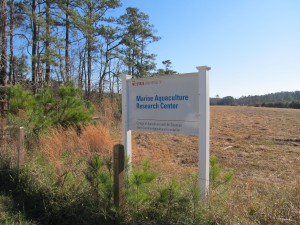
Tucked on the banks of Sleepy Creek between the two small towns of Marshallberg and Smyrna, NC, a world of new aquaculture ideas grows – NC State’s Marine Aquaculture Research Center. A single building with large tanks behind emerged from the landscape as we drove down the dirt farm road that connects the property to the main road. Originally planned as a three-building complex, recent budget cuts felt throughout the state have made the operation smaller – but no less important. The facility houses projects for anyone with an idea for how to forward aquaculture in the 21st century – be they local researchers, students, or people already in the industry. The two major projects happening during our visit are a comparison of hybrid and striped bass feeding efficiencies at a variety of temperatures and continuing development of a waste-management strategy for tank effluent water. There was also a red porgy mating effort and mud minnow spawning setup.
As you turn toward the sign denoting the MARC, you pass a large warehouse and tank facility. This is Dr. IJ Won’s sturgeon farm (a future visit for us) – and credit for the MARC also goes do Dr. Won. He and his wife donated the land across from his sturgeon facility for the development of the MARC in order to advance aquaculture Down East. The region is a rural peninsula extending east of Beaufort to the Atlantic ocean where residents can often trace their family history back to the colonial era. In fact, many of the local accents – the Down East “brogue” – hint at this history without having to pull out the family tree. The peninsula, bordered on three sides by the North Carolina’s famous sounds and ringed by barrier islands, is criss-crossed by small coastal creeks that lazily wind their way to the sea. The MARC is located on one such creek as a large demonstration project – that these small creeks can in fact be used for marine aquaculture without having to compete with wealthy retirees for waterfront property right on the Sounds.
All about water
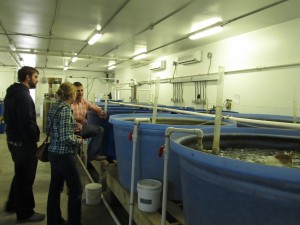
A visit to the MARC definitely leaves you with the impression that water is more important than the fish. Water is transported from Sleepy Creek to the facility’s plumbing through a sump pump mounted on a swinging arm at the end of a thin wooden walkway. At low tide, a tiny spring-fed tributary feeds too much fresh water in the system, so the sump only works during high tide. A preliminary treatment sterilizes the water by chlorination and deposits water in reservoirs, where it sits to settle out sediment. After dechlorination, pumps send the water to the indoor facility, where a number of other treatments happen, depending on which set of tanks the water is destined for. Most have UV sterilization and some form of aeration. The most densely-stocked tanks receive liquid oxygen through injection into the piping.
Creatively-rigged tube monitors allow staff to ensure even water level and flow. The clear tubes are attached to the intake with 4 holes drilled in each one. At full flow, all 4 holes are underwater and the water pressure created by the inflow forces water up the tube. A quick glance at the tubes emerging from each tank ensures that the fish are receiving fresh water – and at a constant rate, removing a potential complicating factor for experiments.
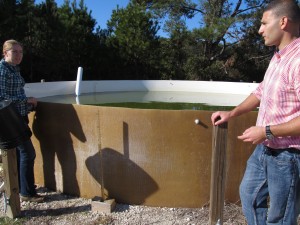
Inflow is the easy side of the equation, however – once fish live in that water and poop in that water, the outflow problem emerges. One of the primary purposes of the MARC is to figure out the best way to deal with this nutrient-rich effluent. Tanks drain into a multiple-step process that begins by separating the solid sludge from liquid water through a conical settling system – sludge settles to the bottom of a cone and is later pumped to an outdoor facility, while a hose with holes poked along the length encircling the middle of the cone captures the liquid portion. The sludge is held in a tank and then pumped into a geometrical fabric tank – it looks like a giant garbage bag in a dark greenhouse – and allowed to sit for up to several years, reacting with fibers in the bag. A side-stream allows some of the water to run through a constructed wetland containing mostly Spartina and another biological treatment system (like the one indoors) containing reactive beads – together these remove most of the nitrogen products, returning it to atmospheric nitrogen.
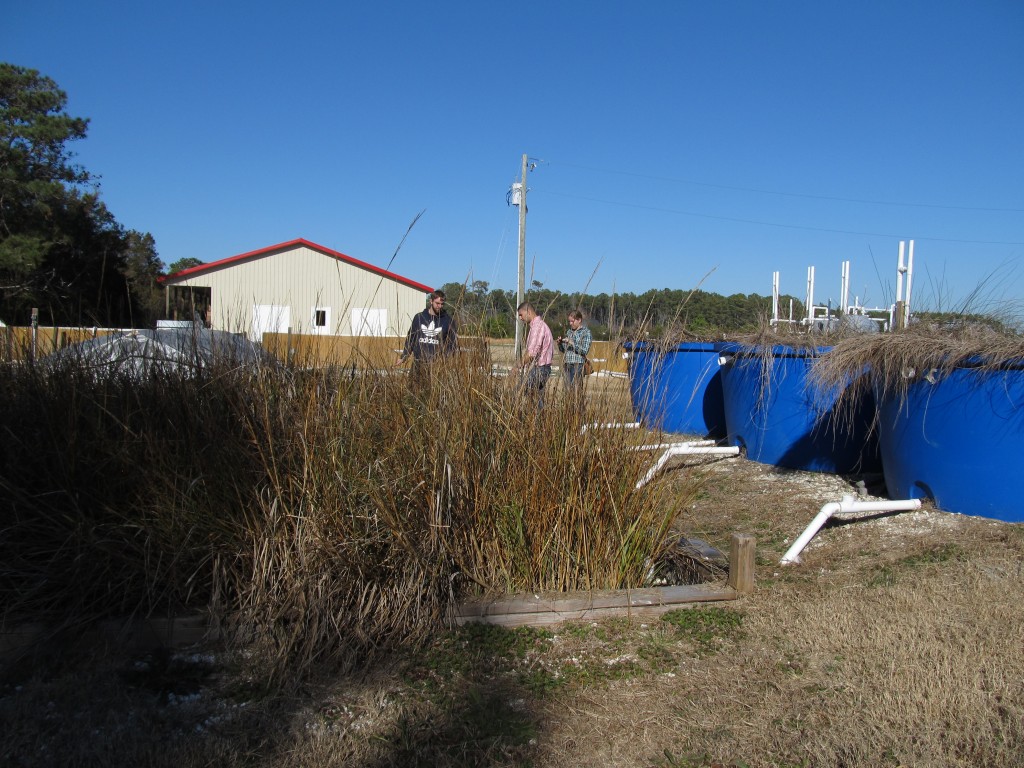
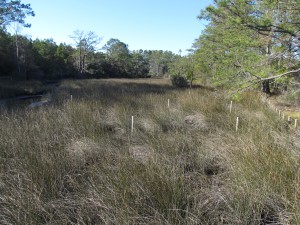
Treated water is sprayed over the wetland bordering Sleepy Creek through a long pipe with small holes drilled in the side, distributing the effluent as thin as possible over a wide area of marsh. Scientists will monitor this area over time to check for any ecological impacts of the effluent. Although nutrients and solids have been removed, there’s still some question over added hormones from the fish or lack of micronutrients used by the fish (that’s why they can’t recycle the water).
The fish
MARC is designed to house whatever projects are funded through state or federal grants. Researchers can rent space for their projects and NC Sea Grant can offer the space to grantees, especially through the Fishery Resource Grant program, which heavily supports aquaculture development in the state. There’s a wet lab and water chemistry lab that allows researchers to monitor what’s going on with their projects in a scientific way. Most of the building, however, is divided into areas with different ongoing projects.
The largest of these experiments is linked to the wastewater development – 12 large blue tanks holding either striped bass or hybrid striped bass at market size. This setup is part of an ongoing investigation of hybrid striped bass aquaculture development – to determine optimum stocking density, feed ratios, the best type of feed, optimum temperature for metabolism and growth, etc.
Other, smaller projects involve attempting to get red porgies to mate (and not jump out of the tank, accomplished currently by covering the tank with an old cast net) and figuring out how mud minnow spawning might work in captivity. There’s quite a bit of stochastic luck involved in fish mating. The porgies apparently aren’t feeling in the mood this year, despite increased health. Last year, relatively stressed and unhealthy porgies created a bumper crop of babies. Not so this year. The mud minnow tanks were thrown together out of whatever happened to be available at the center after the mud minnows spawned a bit earlier than expected and left researchers with thousands of eggs that needed caring for. Luckily, female minnows apparently find tupperware containers with wire grates over top a perfect place to deposit their future generation.
httpv://www.youtube.com/watch?v=EfUz5H3cW10
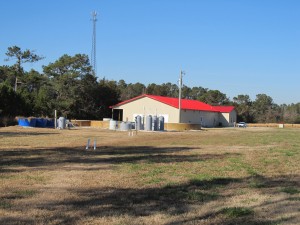
The future
The original, larger, vision of the MARC isn’t gone, even though the funding currently is. Success of the current projects and a turnaround in the state economy might help provide funds for future expansion. Researchers can deliver grants and rent space and locals, like the original enabling grant, can also help support efforts here. Hopefully, says Marc Turano, Sea Grant specialist kind enough to give us the tour, building two will be built, housing researcher offices and some smaller facilities for startup projects.